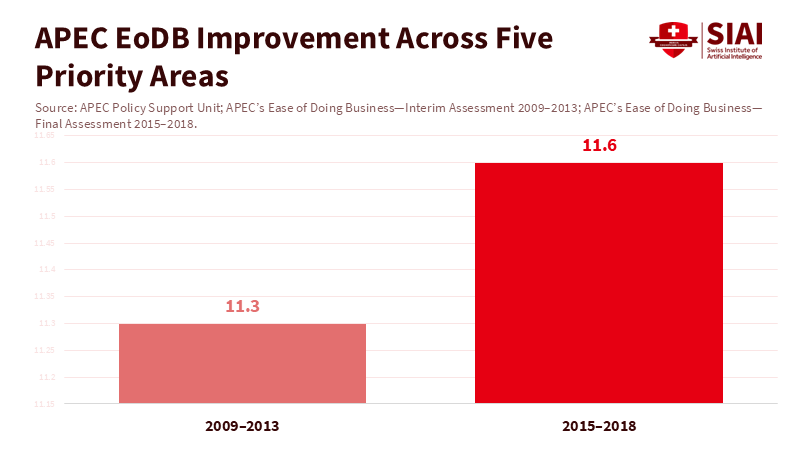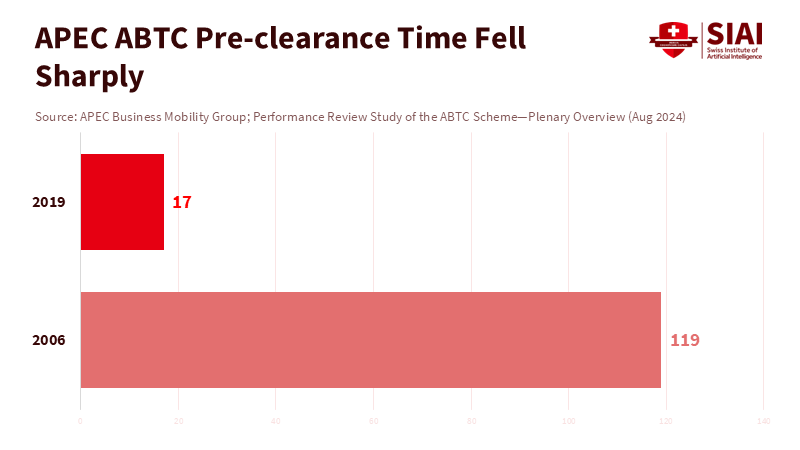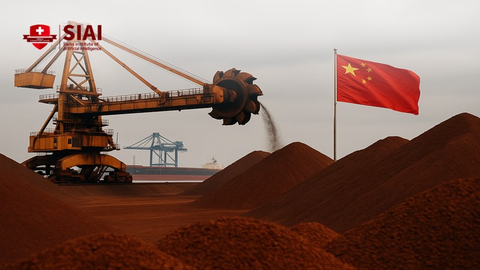APEC Economic Cooperation Delivers Even Without a U.S.-China Truce
Input
Modified
APEC economic cooperation keeps delivering even without a U.S.–China truce Mid-sized members drive results through trade facilitation, mobility, and digital trust Train skills; scale ABTC and CBPR.

This year, there is an apparent fact in the Asia-Pacific policy. APEC economic cooperation still accounts for half the world's traded goods. In 2024, APEC economies accounted for US$12.2 trillion in merchandise exports, or 50% of global merchandise exports. These flows remained strong despite tariff disputes, security issues, and tighter finances. The system is functioning because APEC has spent three decades cutting costs at borders and beyond. The region's integration is not just a headline; it provides tools that reduce friction for businesses, educational institutions, and laboratories every day. Much of the recent progress has nothing to do with a U.S.-China thaw. Instead, it comes from other member countries independently enhancing rules and trust. That is the story we overlook when we focus solely on rivalry. The data shows that APEC economic cooperation remains vital to the regional economy.
APEC Economic Cooperation Beyond Geopolitics
APEC is not a defense agreement. It is a voluntary platform that lowers trade costs. The last 25 years illustrate this point. Two waves of Trade Facilitation Action Plans have reduced region-wide transaction costs by 5% each, while the Ease of Doing Business initiative improved performance by 11.3% from 2009 to 2013 and by 11.6% from 2015 to 2018. These are not soft goals. They represent faster permits, more efficient customs processes, and fewer port delays. The benefits accumulate year after year. They are also lasting because they exist within domestic systems, not in one significant deal. That is why APEC economic cooperation continues to yield results even during political challenges.
Looking at the long-term trends, the average applied tariffs in APEC have decreased from nearly 17% in 1989 to 5.7% by 2012, enabling supply chains to connect across the ocean. This reduction in tariffs has created scale, while facilitation has saved time and money at the border. The real progress, however, lies not just in the vision documents but also in digitized certificates of origin, risk-based inspections, and single-window systems. This is APEC economic cooperation in action, and it's a testament to the enduring benefits of the system.

APEC Economic Cooperation: 25 Years of Results
Consider mobility. The APEC Business Travel Card (ABTC) began as a pilot in 1997. It now includes over 460,000 cardholders across all 21 economies. This card, which allows for pre-clearance and fast-track lanes, has significantly reduced waiting times, eased last-mile connections, and lowered costs for small exporters, researchers, and university technology-transfer teams. Before the pandemic, average pre-clearance times dropped from 119 days in 2006 to 17 days in 2019, demonstrating clear efficiency. The latest review in May 2025 confirmed ongoing improvements and the pressure for reform. Businesses and campuses benefit when trips that once took months to clear can now be accomplished in days. APEC economic cooperation is evident in calendars, not just formal statements.

Data also requires smooth borders. The Cross-Border Privacy Rules, born from APEC, evolved into the Global CBPR Forum, which launched global certifications in June 2025. Participating accountability agents now list a growing number of certified organizations across the United States, Japan, Korea, and beyond. For educational technology providers, cross-border research groups, and student-data platforms, this serves as a practical link. It enables lawful, verifiable data transfers without needing to harmonize with every privacy law. APEC's influence in the Global CBPR Forum underscores its role in shaping global data privacy regulations, making it a key player in the digital economy. Again, APEC's framework is voluntary, interoperable, and scalable. This is why APEC economic cooperation can continue even when formal trade talks stall.
APEC Economic Cooperation Without the U.S. China Truce
The region is not waiting for Washington and Beijing to reach an agreement. The Comprehensive and Progressive Agreement for Trans-Pacific Partnership (CPTPP), which expanded in December 2024 to include the United Kingdom, is a testament to this. Rules for services, e-commerce, and origins were broadened within a network whose core members are APEC members. At the same time, the Regional Comprehensive Economic Partnership (RCEP) has been in effect since 2022, covering about 30% of global GDP and population. While these are not APEC treaties, they extend APEC's principles—open regionalism, clear rules, and consistent paperwork—through binding agreements. APEC's role in shaping the CPTPP expansion underscores its influence on regional trade agreements, making it a key player in the regional trade landscape. Mid-sized and smaller APEC economies are leveraging these frameworks to hedge risks, secure market access, and raise standards. At the same time, the major powers engage in disputes. That is where the quiet progress is happening.
Skepticism remains about a quick U.S.-China agreement, and understandably so. Trade ministries across the region have warned that new rounds of tariffs and export controls are affecting trade in goods. In May 2025, ministers reported a sharp slowdown in APEC export growth, citing the impact of U.S. tariff actions. Their message was cautious: keep markets open but prepare for reduced demand and additional policy shocks. If a bilateral agreement is reached, it could serve as a catalyst. If not, APEC economic cooperation already bears much of the burden. The rest of the membership is proving that rule-based integration can continue regardless.
APEC Economic Cooperation for Schools, Skills, and Firms
The benefits of APEC economic cooperation in human capital are often overlooked. The education and labor streams have focused on employability, digital skills, and mobility since the APEC Education Strategy (2016–2030). Recent ministerial meetings in October 2025 emphasized structural reform, financial inclusion, and innovation. For universities and public training institutions, the implications are tangible. Align micro-credentials with logistics, digital trade, and compliance tasks that businesses must master to navigate APEC's framework. Develop short, stackable modules in export documentation, privacy engineering, and sustainability reporting. These travel well across borders and meet real demand. The lesson is to teach what's needed at the border—because that is where value leaks.
Mobility and trust are the tools schools can use now. Increase ABTC access for university commercialization teams and small and medium-sized enterprise partners where rules permit. Map scholarship and internship pathways to ABTC corridors to reduce barriers for both outbound and inbound placements. For data handling, adopt Global CBPR or align internal controls to its framework. This reduces risks for cross-border educational technology platforms and collaborative research labs. None of this requires a handshake between superpowers. It requires registrars, deans, export-promotion agencies, and privacy officers to treat APEC economic cooperation as a practical toolkit. When they do, students and businesses progress faster, learn more, and incur fewer costs during transit.
The same principles apply to local governments and chambers of commerce. Implement single-window customs integration to support first-time exporters. Encourage paperless certificates of origin and pre-arrival processing. The old TFAP lesson holds: reducing minutes and paperwork saves money. Pair this with targeted training on documentation, product standards, and market entry. If your economy is part of RCEP or trades with CPTPP markets, adjust curricula and advisory services to fit those regulations. The practical result is to turn high-level agreements into everyday accomplishments for smaller businesses. This is what APEC economic cooperation was designed to achieve.
We started with a precise observation: APEC economic cooperation continues to support the global trading system. US$12.2 trillion in exports in 2024, and half of the world's merchandise trade is not a coincidence. It results from years of tariff reductions, faster customs, trusted travel, and improved digital safeguards. A significant U.S.-China deal would be beneficial. It might even represent a turning point. However, the region cannot wait for that agreement. The last two years demonstrate that the other 19 economies can continue to deepen integration, broaden rules, and train people to utilize them. The call to action is straightforward and persistent. Continue to reduce trade costs that don't require headlines. Continue scaling ABTC, paperless trade, and Global CBPR. Keep teaching the practical skills that allow businesses and labs to move goods, people, and data confidently. If a truce comes, the system will handle even more. If it doesn't, the existing framework will still function. This is how the region continues to achieve gains—calmly and without delay.
The views expressed in this article are those of the author(s) and do not necessarily reflect the official position of the Swiss Institute of Artificial Intelligence (SIAI) or its affiliates.
References
APEC. (2014). APEC at 25 Years (Infographic). Singapore: APEC Secretariat.
APEC. (2024). APEC in Charts 2024. Singapore: APEC Secretariat.
APEC. (2025). APEC Finance Ministers Confront Fiscal Pressures and Digital Shifts in Incheon (news release). Singapore: APEC Secretariat.
APEC Policy Support Unit. (2011). Aggregate Measurement of Trade Transaction Costs in APEC 2007–2010 (TFAP II). Singapore: APEC Secretariat.
APEC Policy Support Unit. (2016). APEC’s Ease of Doing Business—Final Assessment 2009–2015. Singapore: APEC Secretariat.
APEC Policy Support Unit. (2019). APEC’s Ease of Doing Business—Final Assessment 2015–2018. Singapore: APEC Secretariat.
APEC Statistics (StatsAPEC). (2024). Exports of Merchandise Goods: share of world total. Singapore: APEC Secretariat.
APEC, Business Mobility Group. (2024). Performance Review Study of the ABTC Scheme (meeting document). Singapore: APEC Secretariat.
APEC, Business Mobility Group. (2025). Performance Review Study of the APEC Business Travel Card (ABTC) Scheme—Final Report. Singapore: APEC Secretariat.
ASEAN Secretariat. (2022). RCEP to Enter into Force on 1 January 2022 (press release) and RCEP overview. Jakarta: ASEAN.
Department for Business and Trade (UK). (2024). UK counting down to CPTPP entry into force; CPTPP collection. London: GOV.UK.
DFAT (Australia). (2022). Regional Comprehensive Economic Partnership—Agreement in Force. Canberra: Department of Foreign Affairs and Trade.
Global CBPR Forum. (2024–2025). Policies, Rules and Guidelines; Certified Organizations Directory.
Reuters. (2025, May 15). APEC warns of stalling trade due to tariffs as China, U.S. officials meet.
UK Government/Business. (2024). CPTPP in force for the United Kingdom from 15 December 2024. London.





















